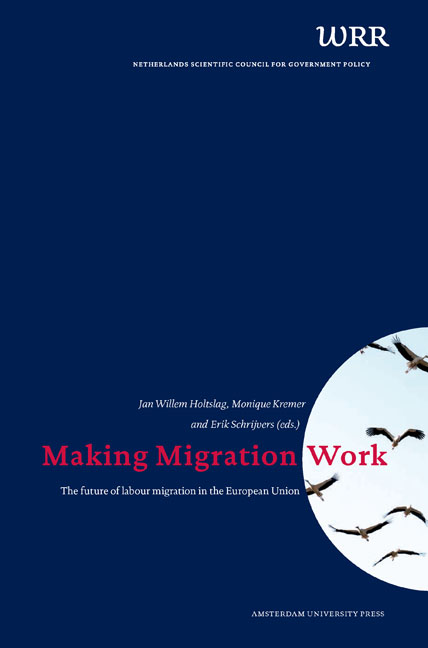Book contents
- Frontmatter
- Contents
- Introduction
- Acknowledgements
- 1 How to Make Migration Work
- 2 The Global and European Neighbourhood Migration Systems: Trends, Policy Choices, Governance Challenges and a Look Ahead
- 3 Satisfying Labour Needs in an Ageing Society
- 4 Migrant Workers: Inevitability or Policy Choice?
- 5 Intra-EU Labour Mobility after Eastern Enlargement and During the Crisis: Main Trends and Controversies
- 6 Labour Migration From Central and Eastern Europe and the Implications for Integration Policy
- About the Authors
5 - Intra-EU Labour Mobility after Eastern Enlargement and During the Crisis: Main Trends and Controversies
Published online by Cambridge University Press: 23 June 2021
- Frontmatter
- Contents
- Introduction
- Acknowledgements
- 1 How to Make Migration Work
- 2 The Global and European Neighbourhood Migration Systems: Trends, Policy Choices, Governance Challenges and a Look Ahead
- 3 Satisfying Labour Needs in an Ageing Society
- 4 Migrant Workers: Inevitability or Policy Choice?
- 5 Intra-EU Labour Mobility after Eastern Enlargement and During the Crisis: Main Trends and Controversies
- 6 Labour Migration From Central and Eastern Europe and the Implications for Integration Policy
- About the Authors
Summary
INTRODUCTION
The accession of eight new Central and Eastern European countries (EU8) to the EU in May 2004 and the subsequent accession of Romania and Bulgaria in January 2007 (EU2) marked an important step in the history of European integration. It reunited a continent divided since the Second World War. An important consequence was the extension of the free movement of capital, goods, services and people to Central and Eastern Europe. European law guarantees these freedoms within the EU – in principle. However, in light of the large differences in wages, for example, there were fears of a massive influx of workers from the new Member States with expected negative impacts on the receiving countries’ labour markets (and welfare systems). As a result, all but three countries (the United Kingdom, Ireland and Sweden) made use of so-called transitional measures in 2004. These transitional measures restricted – to varying degrees – the right to work for EU8 citizens in EU15 countries for a period of up to seven years.
EU15 countries successively opened their labour markets over the subsequent years, however, and only Germany and Austria made use of the entire seven-year transition period, fully opening up their labour markets only in May 2011. Workers from Bulgaria and Romania will not have complete freedom of movement until January 2014; currently, 11 Member States still have transitional measures in place with regard to EU2 workers, in several cases with simplified procedures or exceptions for certain groups of workers or certain sectors. The darkening economic outlook from the summer of 2007 onwards was a major factor here. Interestingly, Spain temporarily re-introduced restrictions on new Romanian workers in July 2011, a step that was justified with reference to the labour market impact of the crisis.
Post-2004 labour mobility constitutes a historically new phenomenon in a number of respects, exhibiting characteristics that distinguish it from its previous forms as a result of EU enlargements. First of all, it is a multifaceted process, with different forms of labour mobility co-existing in a rapidly changing environment, a factor whose importance has more recently been further accentuated by the economic crisis.
- Type
- Chapter
- Information
- Making Migration WorkThe Future of Labour Migration in the European Union, pp. 83 - 104Publisher: Amsterdam University PressPrint publication year: 2013

